Ijraset Journal For Research in Applied Science and Engineering Technology
- Home / Ijraset
- On This Page
- Abstract
- Introduction
- Conclusion
- References
- Copyright
IOT Based Agriculture Monitoring System
Authors: Mr. Jayramdas R. Bhelave, Mr. Gaurav V. Kapse, Mr. Babaji Manjare, Mr. Nilesh Barne, Ass. Prof. Sonali N. Parab
DOI Link: https://doi.org/10.22214/ijraset.2022.40592
Certificate: View Certificate
Abstract
In earlier days farmers want to calculate the readiness of soil and impacted doubts to make which of the kind of yield. They didn\'t consider the stickiness, level of water and particularly atmosphere condition which was difficult to a Farmer, progressively the Internet of Things (IoT) is renovating the agribusiness engaging the agriculturists through the broad scope of methodologies, for example, exactness even as useful cultivating to manage difficulties within the field. IoT helps in the get-together data on conditions like atmosphere, protection, temperature, and productivity of the soil. IoT improvement can decrease the expense and update the efficiency of ordinary creating for farmers.
Introduction
I. INTRODUCTION
IoT could be a combination of knowledge, web associated items, which is an integral component of the long run Internet. IoT focuses on the automation of processes to cut back human intervention. IoT in agriculture focus is on automating the aspects of agricultural methods to form them more efficient and effective. Traditional approaches of farming don't include livestock management and have many inefficiencies like higher human interaction, labor cost, power consumption, water consumption, etc. The use of a wireless sensor network is finished during this project which collects the information from different sensors and sends it to the most server using wireless protocols. the info that's collected during the method provides the data about different environmental factors which is employed to watch the complete process. Monitoring environmental factors aren't the answer to boost yield, quality, and production of the crops. it's necessary to develop a combined and unique system that can make sure of all factors affecting productivity like cultivation, harvesting, and post-harvesting storage.
II. METHODOLOGY
IoT could be a combination of knowledge, web associated items, which is an integral component of the long run Internet. IoT focuses on the automation of processes to cut back human intervention. IoT in agriculture focus is on automating the aspects of agricultural methods to form them more efficient and effective. Traditional approaches of farming don't include livestock management and have many inefficiencies like higher human interaction, labor cost, power consumption, water consumption, etc. The use of a wireless sensor network is finished during this project which collects the information from different sensors and sends it to the most server using wireless protocols. the info that's collected during the method provides the data about different environmental factors which is employed to watch the complete process. Monitoring environmental factors aren't the answer to boost yield, quality, and production of the crops. it's necessary to develop a combined and unique system that can make sure of all factors affecting productivity like cultivation, harvesting, and post harvesting.
We read within the newspapers for several days about farmers’ losses and farmers want to determine the soil maturity and suspicions for the assembly of yield. They won’t worry about the temperature, water level, and easily climate conditions that are terrible to farmers. the web of Things (IoT) is reconstructing the agri-business which enables farmers to pander to challenges within the field, as an example through a broad range of strategies, like accuracy and practical farming.
IoT assists within the assembling of knowledge regarding conditions like climate, humidity, temperature, and soil fertility, a IoT-based examination enables the invention of untamed plants, water levels, exact location, field interruption, field development, horticulture. IoT helps in assembling information IoT uses farmers to attach from anywhere to his house. Remote sensors are accustomed track household conditions and smaller controls are wont to control and mechanize the house shapes.
- The sensor network deployed in each section will keep updating the parameter readings in the MY-SQL database through a WIFI communication module.
- Any changes with the data that can trigger to set the alarm will also be recorded and notified at the server room.
- The concerned authorities or the locals can access the data and the warning notifications of the same.
- The data is stored in the MY-SQL Database called PHP Web server, where it can be used to make some analysis on fields.
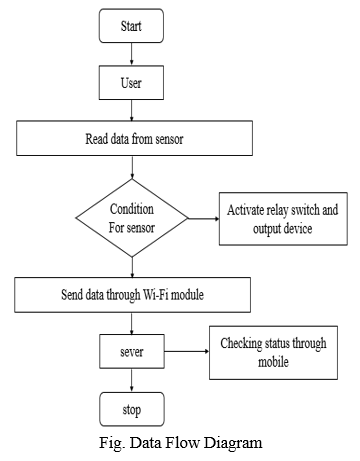
III. SYSTEM ARCHITECTURE
- To make a farmer understand the working of big labour machines and tech devices we valuable and realistic technology for monitoring.
- To prevent this smuggling, in this project we use various sensors like soil moisture, temperature, humidity, fire, and buzzer sensor. And we use Wi-Fi communication purpose.
- In this proposed system a novel method has been introduced to prevent the cut down of trees using a server called PHP Web.
- The tilt sensor is used to determine whether the tree is cut down or not similarly temperature sensor is used to determine whether the field is on fire or not, moisture sensor checks the moisture content in the soil, and relay switch activates based on the behaviour of the sensor which is implemented in fields.
- This value will be constantly sent to the MY-SQL database through Wi-Fi which can be accessed using a Web view application.
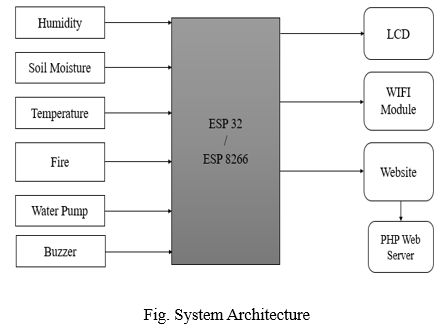
IV. MODULES
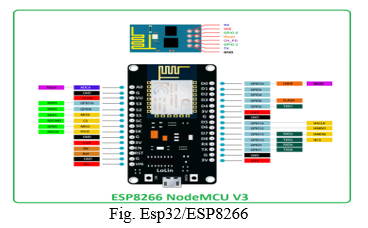
ESP32 could be a series of a low-cost, low-power systems on chip microcontrollers with integrated Wi-Fi and dual-mode Bluetooth. The ESP32 series employs either a Ten silica Extensa LX6 microprocessor in both dual-core and single-core variations, Extensa LX7 dual-core microprocessor, or a single-core RISC-V microprocessor and includes built-in antenna switches, RF balun, power amplifier, low-noise receive amplifier, filters, and power management modules. ESP32 is formed and developed by Express if Systems, a Shanghai-based Chinese company, and is manufactured by TSMC using their 40 nm process. It's a successor to the ESP8266 microcontroller.
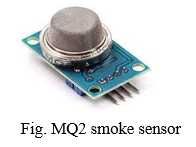
Smoke alarms detect fires by sensing small particles within the air employing a few different sorts of technologies. Once they detect those particles above a specific threshold, they signal the alarm to sound so you and your family can get to safety and call 911. Smoke alarms save lives behavior of the Sensor, Arduino board starts working, following are the functionalities.
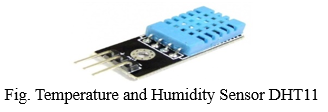
The DHT11 is a basic, ultra low-cost digital temperature and humidity sensor. It uses a capacitive humidity sensor and a thermistor to measure the surrounding air and spits out a digital signal on the data pin (no analog input pins needed).
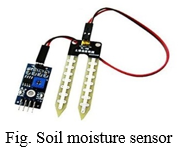
A resistive soil moisture sensor works by using the link between impedance and water content to measure the moisture levels of the soil. When the water content within the soil is low, it's poorer electrical conductivity. Hence, a better resistance reading is obtained, which indicates low soil moisture.
V. LITERATURE SURVEY
A. IOT Based Smart Agriculture Monitoring and Irrigation System
For many days about farmers' losses and farmers used to work out the soil maturity and suspicions for the production of yield. They won't worry about the temperature, water level, and simply climate conditions that are terrible to farmers. The Internet of Things (IoT) is reconstructing the agri-business which enables farmers to deal with challenges in the field, for example through a broad range of strategies, such as accuracy and practical farming.
B. "Wireless Sensor Network Survey." Computer networks 52.12 (2008) :
Unlike other networks, WSNs are designed for specific applications. Applications include, but are not limited to, environmental monitoring, industrial machine monitoring, surveillance systems, and military target tracking. Each application differs in features and requirements. To support this diversity of applications, the development of new communication protocols, algorithms, designs, and services is needed.
C. Sensor Networks: an Overview
Sanjay Kumar Madria is an Assistant Professor, Department of Computer Science, at the University of Missouri-Rolla, USA. Earlier he was Visiting Assistant Professor in the Department of Computer Science, Purdue University, West Lafayette, IN. He has widely published papers in journals and conferences in his areas of research interest that include sensor networking, mobile computing, web data management, and transaction processing.
D. Implementation of a wireless sensor network with EZ430-RF2500 development tools and MSP430FG4618/F2013 experimenter boards from Texas instruments
The ultralow-power and low-cost devices from Texas Instruments. By applying a polling scheme with channelization and Wake-On-Radio, the reduction of power consumption is achieved. The total system power can be obtained by measuring every single device.
E. Design of Forest Fire Early Detection System Using Wireless Sensor Networks
The protection of nature reserves of forest fires is possible with this type of network, as it allows not only set a parameter for continuous monitoring of the signal but at the same time allows more resources to optimize such as energy and the reduction of traffic characteristics with the administration of large networks to generate significant benefits for small networks are indistinguishable.
F. A review on Partial Root-zone Drying Irrigation
Diverse crop species show ed that in comparison to the traditional deficit irrigation strategy (DI) that the crop is subjected to some degree of water stress, PRD is successfully alternative irrigation compared to FI that can save irrigation water up to approximately 50% without significant yield loss, while may improve the yield quality.
However, the amount of saved irrigation water and improved WP strongly depends on the crop, soil, and site specifications. Moreover, cumulative results revealed that PRD could not be effective in reproductive crops that are sensitive to water stress. In such cases the recommended strategy is that irrigation events should be more frequent and supplementary full irrigation should be applied in sensitive phonological periods of crop growth. Since PRD is newly applied to some tree species, it is recommended to do more studies on different kinds of trees in different environmental conditions.
G. Real-Time Atomization of Agricultural Environment for Social Modernization of Indian Agricultural System Using Arm 7
The proposed system is very used full for regular monitoring of farm status without visiting manually and saves time and also use full to monitor hilly areas and remote areas, which were hard to visit manually.
The system not only saves energy consumption significantly but also reduces a large number of input on the human and material resources in the management.
Applying embedded technology and ZigBee wireless transceiver technology to the rapid deployment system of the incident detection of emergency food storage environment without complicated connections, enhances the system’s flexibility, small size, low cost, and good effectiveness, so it is easy to install and migrate.
H. Energy-efficient Automated Control of Irrigation in Agriculture by using Wireless Sensor Networks
The automated irrigation system proposed is based on the use of a novel routing protocol named CHIRP. The utilization of this protocol offers remarkable energy efficiency. The development of novel systems, like the one proposed in this paper, which combines efficient irrigation models along with energy-efficient utilization of WSNs shows to be a very promising and effective application of automation in agriculture. The proposed model can be further extended to consider the effect of the field characteristics on the quantity of water required for irrigation.
VI. LITERATURE SURVEY IN SUCCINT
|
Sr. No |
Author and Year |
Name of paper |
Paper is about |
Result |
Conclusion / Remark |
|
1 |
Swaraj C M, K M Sowmyashree (2020) |
IoT based Smart Agriculture Monitoring and Irrigation System |
The design also helps in decreasing global warming to a grand period. |
Inventing in the specialization where the crops are costly are monitored and all the climatic requirements are well preserved essential. |
The innate habit of plants is controlled indirectly. The plants can also be saved from fire by use. This in turn helps in decreasing crop obliteration. Thereby, the ecological equilibrium is preserved. |
|
2 |
Yick, Jennifer, Biswanath Mukherjee, and Dipak Ghosal (2008) |
Wireless |
WSN applications such as communication architectures, |
Close the gap between technology and application. |
Studied WSN applications such as communication architectures, security, and management between technology and application. |
|
3 |
Tubaishat, M., & Madria, S. (2003) |
Sensor networks: an overview |
Sensor networks should sustain network connectivity actually if some of their sensors are transferred. |
Sensors are their ability to maintain connectivity in case of movement. As these sensors are very tiny, they are vulnerable to being accidentally moved. |
Data produced by the sensors usually have to be routed through several intermediate nodes to reach their destination. |
|
4 |
Yang, L. D. (2011) |
Implementation of a wireless sensor network with EZ430-RF2500 development tools and MSP430FG4618/F2013 experimenter boards from Texas instruments. |
A wireless sensor network is implemented with eZ430RF2500 wireless development tools and MSP430FG4618/F2013 experimenter boards, ultralow-power, and low-cost devices from Texas Instrument. |
It can be proved that the temperature displayed on the PC is one period ago for the slave boards and two periods ago for the eZ430RF2500 nodes each time when the display is refreshed. |
Every device has to be programmed to sense the temperature immediately after querying. |
|
5 |
Lozano, C., & Rodriguez, O. (2011) |
Design of forest fire early detection system using wireless sensor networks. Electronics and Electrical Engineering |
Prevention of forest fires using wireless sensor networks. |
Protection of nature reserves from forest fires is possible with this type of network. |
When deploying network equipment is set correctly selected all measures are and generates alarms when the temperature exceeds the threshold. |
|
6 |
Sepaskhah, A. R., & Ahmadi, S. H. (2012) |
A review on partial root-zone drying irrigation |
Wide applications of partial root-zone drying irrigation (PRD) on diverse plant species. |
PRD is successful alternative irrigation compared to FI that can save irrigation water up to approximately 50% without significant yield loss, while may improve the yield quality. |
The amount of saved irrigation water and improved WP strongly depends on the crop, soil, and site specifications. |
|
7 |
Galgalikar, M. M. (2010) |
Real-time automization of agricultural environment for social modernization of Indian agricultural system |
ARM7 and GSM are concentrating on automizing the irrigation scheme for the social interest of the Indian farming technique. |
The system not only saves energy consumption significantly but also reduces a large number of input on the human and material resources in the management. |
Enhances the system’s flexibility, small size, low cost, and good effectiveness, so it is easy to install and migrate. |
|
8 |
Nikolidakis, S. A., Kandris, D., Vergados, D. D., & Douligeris, C. (2015). |
Energy efficient automated control of irrigation in agriculture by using wireless sensor networks. |
Automatic irrigation managing with an Avant book routing protocol for Wireless Sensor Networks (WSNs), called ECHERP (Equalized Cluster Head Election Routing Protocol). |
Raised to evaluate the impact of the area features on the amount of water needed for irrigation. |
Efficient irrigation ideals along with energy-efficient utilization of WSNs display to be a very favorable and adequate application of industrialization in farming. |
VII. ACKNOWLEDGEMENTS
This paper wouldn't be written without the respected advice of Asst. Prof S. N. Parab. Our special thanks visit all the professors of the computer engineering department of PK Technical Campus for their support and for giving a chance to figure on a survey of software task extraction and navigation.
Conclusion
In this manner, we are increasing the system which ready to control agriculture monitoring in fields where masses aren\'t capable to produce security. Such a system we are developing within the field where the crops are costly are monitored and every one the atmospheric condition is well maintained important. during this area, we are providing such a reasonable system. Thus, this effective and reliable system helps in agriculture monitoring. except for the most objective, the system also helps in reducing warming to an excellent extent. The natural habit of plants is prevented indirectly. The plants can even be shielded from fire by using this technique. This successively helps in reducing crop destruction. Thereby, the ecological balance is maintained.
References
[1] Pick, Jennifer, Biswanath Mukherjee, and Dipak Ghosal. \"Wireless sensor network survey.\" Computer networks 52.12 (2008): 2292-2330. [2] Tubaishat, M., &Madria, S. (2003). Sensor networks: an overview. IEEE potentials, 22(2), 20-23. [3] Yang, L. D. (2011). Implementation of a wireless sensor network with EZ430-RF2500 development tools and MSP430FG4618/F2013 experimenter boards from Texas instruments. [4] Lozano, C., & Rodriguez, O. (2011). Design of forest fire early detection system using wireless sensor networks. Electronics and Electrical Engineering, 3(2), 402-405. [5] Nakamura, F. G., Quintão, F. P., Menezes, G. C., & Mateus, G. R. (2005, April). An optimal node scheduling for flat wireless sensor networks. In International Conference on Networking (pp. 475-482). Springer, Berlin, Heidelberg. [6] Kovács, Z. G., Marosy, G. E., &Horváth, G. (2010,October). Case study of a simple, low-power WSN implementation for forest monitoring. In 2010 12th Biennial Baltic Electronics Conference (pp.161-164). IEEE. [7] Galgalikar, M. M. (2010, February). Real-time automization of agricultural environment for social modernization of Indian agricultural system. In 2010 The 2nd International Conference on Computer and Automation Engineering (ICCAE) (Vol. 1, pp. 286-288). IEEE. [8] Sepaskhah, A. R., & Ahmadi, S. H. (2012). A review on partial root-zone drying irrigation. International Journal of Plant Production, 4(4),241-258. [9] Nikolidakis, S. A., Kandris, D., Vergados, D. D., &Douligeris, C.(2015). Energy efficient automated control of irrigation in agriculture. [10] Nikesh G, R. S. Kawitkar,2016, “IOT based smart agriculture”, IJARCCE, Volume 5, Issue 6, 2016. [11] Zhao. W, Lin. S, Han. J, Xu. R and Hou. L, 2017, ”Design and Implementation of Smart Irrigation System Based on LoRa,”, IEEE GC Workshops. [12] Dr. V. Vidya Devi, G. Meena Kumari, 2013, “Real-Time Automation and Monitoring System for Modernized Agriculture” IJRRASE Vol3 No.1. PP 7-12. [13] Shruthi B S, KB Manasa, Lakshmi R, 2019, “Survey on Challenges and Future Scope of IoT in Healthcare and Agriculture”, international journal on computer science and mobile computing. [14] Prem Prakash Jayaraman et all, ”Internet of things platform for smart farming: Experiences and lessons learned”, Sensors 2016, 16, 1884; DOI: 10.3390 / s16111884.
Copyright
Copyright © 2022 Mr. Jayramdas R. Bhelave, Mr. Gaurav V. Kapse, Mr. Babaji Manjare, Mr. Nilesh Barne, Ass. Prof. Sonali N. Parab. This is an open access article distributed under the Creative Commons Attribution License, which permits unrestricted use, distribution, and reproduction in any medium, provided the original work is properly cited.

Download Paper
Paper Id : IJRASET40592
Publish Date : 2022-03-03
ISSN : 2321-9653
Publisher Name : IJRASET
DOI Link : Click Here
 Submit Paper Online
Submit Paper Online

